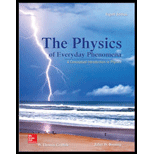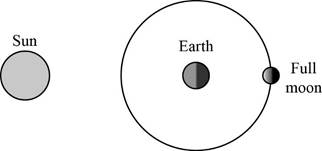
(a)
The fraction of total orbital period of earth through which it move in one period of the moon’s orbit.
(a)
Answer to Problem 6SP
The fraction of total orbital period of earth through which it move in one period of the moon’s orbit is
Explanation of Solution
Given Info: The period of moon’s orbit about the Earth is
The period of orbital motion of Earth is
Write the expression for the fraction of total orbital period of Earth through which it move in one period of the moon’s orbit.
Write the fraction
Conclusion:
Thus, the fraction of total orbital period of earth through which it move in one period of the moon’s orbit is
(b)
The sketch of the sun, the Earth and the moon with the moon in the Full moon condition and also the sketch of the position where the moon would be in
(b)
Answer to Problem 6SP
The sketch of the sun, the Earth and the moon with the moon in the Full moon condition is given in figure 1.and the sketch of the position where the moon would be in
The moon will not be a full moon since the apparent advance of the moon in
Explanation of Solution
When the moon is full, it is on the opposite side of the Earth from the sun. The sketch of the sun, the Earth and the moon with the moon in the Full moon condition is plotted in figure 1.

Figure 1
Write the expression for the angle through which the moon or the Earth advances in one day.
Here,
Substitute
Substitute
Find the apparent advance of the moon relative to sun earth system in one day.
Here,
Find the apparent advance of the moon in
The moon is not full moon yet.
The sketch of the position where the moon would be in

Figure 2
Conclusion:
Thus, the sketch of the sun, the Earth and the moon with the moon in the Full moon condition is plotted in figure 1 and the sketch of the position where the moon would be in
(c)
The extra angle through which the moon have to go to reach the full moon condition and to show it represents approximately an extra two days.
(c)
Answer to Problem 6SP
The extra angle through which the moon has to go to reach the full moon condition is
Explanation of Solution
From part (b), the angle advanced by moon in
Therefore the extra angle that it can have to go to reach the full moon condition is obtained by subtracting apparent angle advanced by moon to total angle.
Find the extra angle for the moon to reach full moon condition.
Here,
Write the expression for the time taken to reach full moon condition.
Here,
Substitute
Conclusion:
Thus, the extra angle through which the moon has to go to reach the full moon is condition
Want to see more full solutions like this?
Chapter 5 Solutions
The Physics of Everyday Phenomena
 College PhysicsPhysicsISBN:9781305952300Author:Raymond A. Serway, Chris VuillePublisher:Cengage Learning
College PhysicsPhysicsISBN:9781305952300Author:Raymond A. Serway, Chris VuillePublisher:Cengage Learning University Physics (14th Edition)PhysicsISBN:9780133969290Author:Hugh D. Young, Roger A. FreedmanPublisher:PEARSON
University Physics (14th Edition)PhysicsISBN:9780133969290Author:Hugh D. Young, Roger A. FreedmanPublisher:PEARSON Introduction To Quantum MechanicsPhysicsISBN:9781107189638Author:Griffiths, David J., Schroeter, Darrell F.Publisher:Cambridge University Press
Introduction To Quantum MechanicsPhysicsISBN:9781107189638Author:Griffiths, David J., Schroeter, Darrell F.Publisher:Cambridge University Press Physics for Scientists and EngineersPhysicsISBN:9781337553278Author:Raymond A. Serway, John W. JewettPublisher:Cengage Learning
Physics for Scientists and EngineersPhysicsISBN:9781337553278Author:Raymond A. Serway, John W. JewettPublisher:Cengage Learning Lecture- Tutorials for Introductory AstronomyPhysicsISBN:9780321820464Author:Edward E. Prather, Tim P. Slater, Jeff P. Adams, Gina BrissendenPublisher:Addison-Wesley
Lecture- Tutorials for Introductory AstronomyPhysicsISBN:9780321820464Author:Edward E. Prather, Tim P. Slater, Jeff P. Adams, Gina BrissendenPublisher:Addison-Wesley College Physics: A Strategic Approach (4th Editio...PhysicsISBN:9780134609034Author:Randall D. Knight (Professor Emeritus), Brian Jones, Stuart FieldPublisher:PEARSON
College Physics: A Strategic Approach (4th Editio...PhysicsISBN:9780134609034Author:Randall D. Knight (Professor Emeritus), Brian Jones, Stuart FieldPublisher:PEARSON





